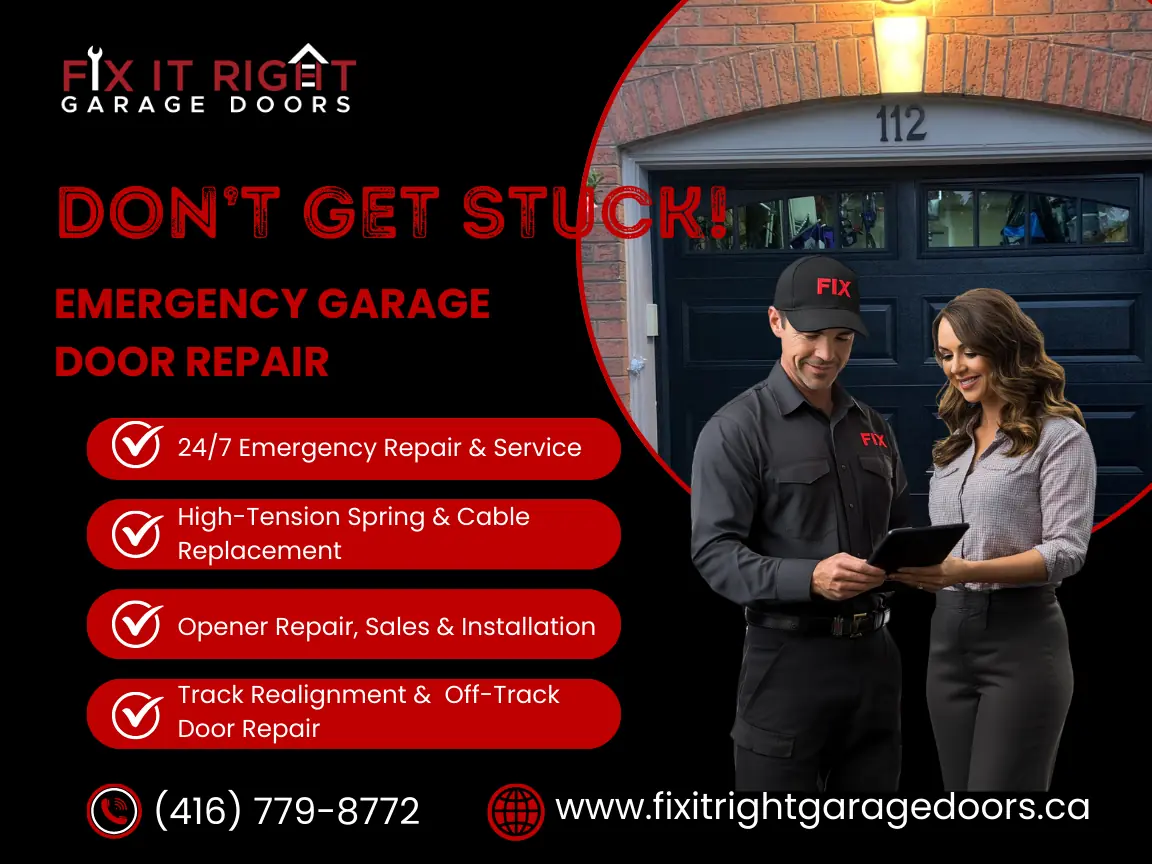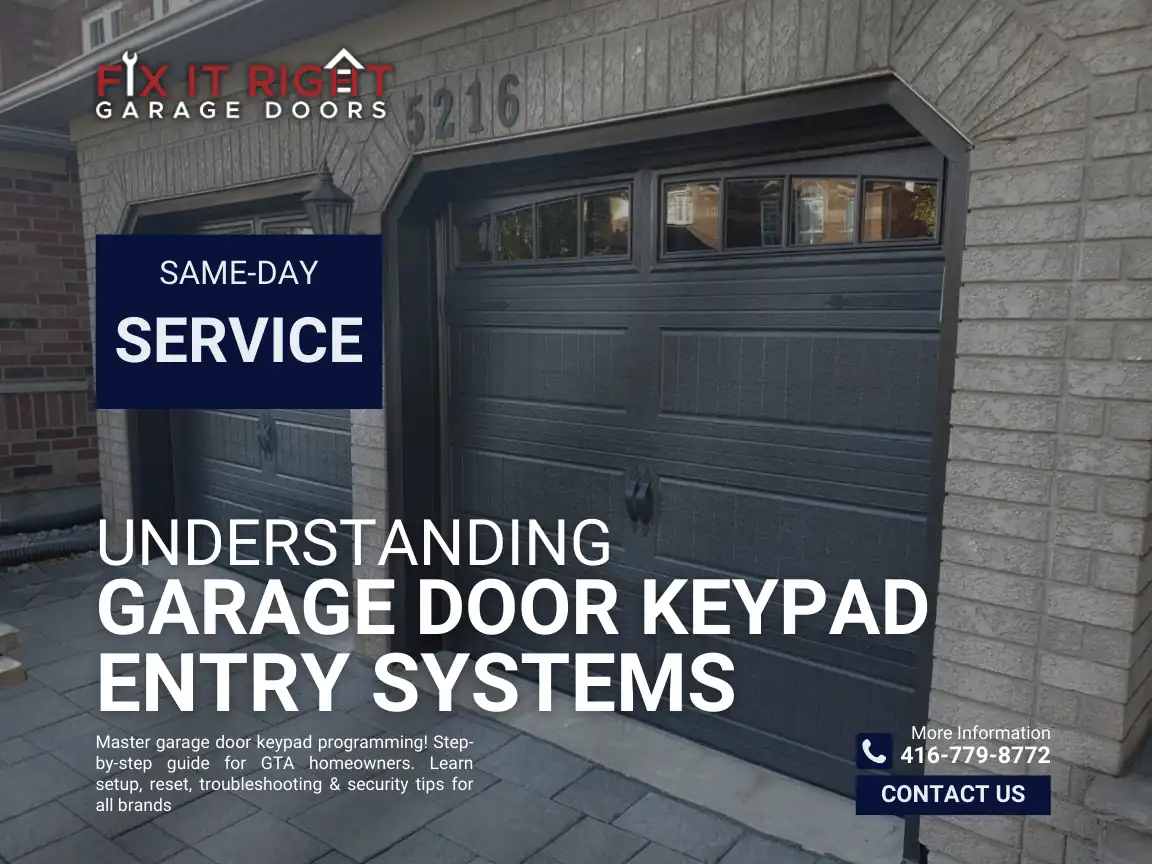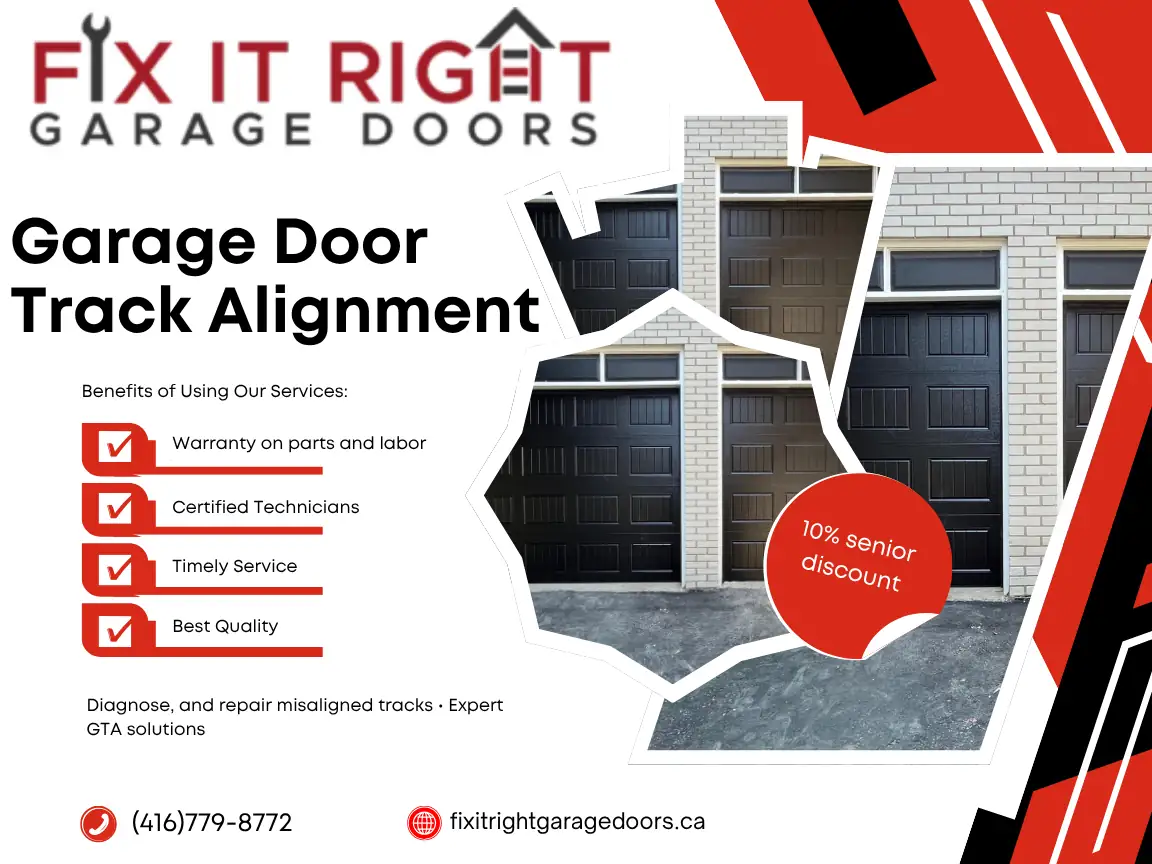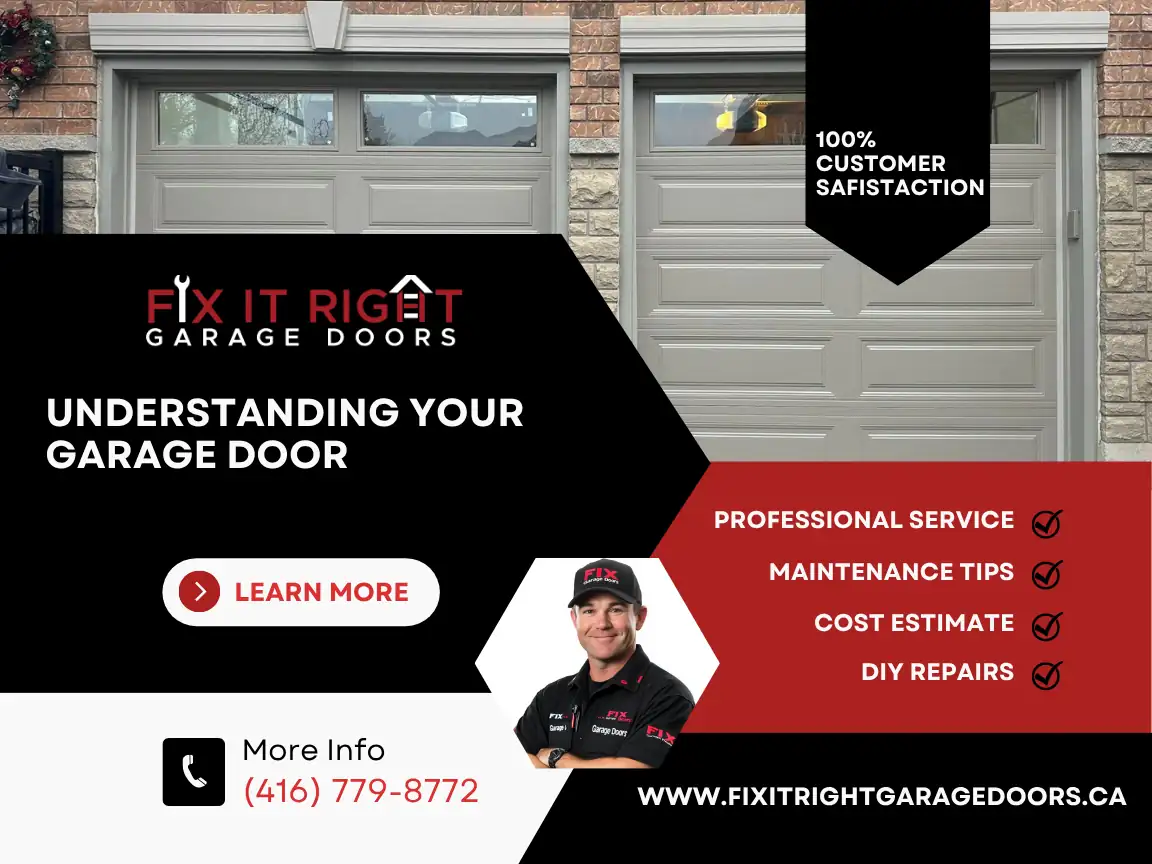A garage door can be the unsung hero of your home. It stands up to Toronto’s harsh winters, guards your vehicles, and provides a critical entry point—yet it often doesn’t get attention until something goes wrong. When that moment arrives, deciding between garage door repair vs replace can feel overwhelming. Is the fix simple or too costly to be worth it? Would a brand-new door better serve your needs, especially considering the new garage door cost GTA might be more affordable than you think in the long run?
This comprehensive guide navigates those questions, exploring when repairs can keep an older door going and when replacement is the more prudent choice. We’ll cover:
- Key indicators that your door may be past its prime.
- Repair scenarios that deliver good value and extend a door’s functional life.
- Factors affecting new garage door cost GTA—from materials to labor.
- The average lifespan of garage doors in Toronto and how climate affects wear and tear.
- Investing in a new door ranks as the best ROI home improvement project for many homeowners.
- The benefits of an insulated garage door, both for comfort and energy efficiency.
By the end, you’ll have the knowledge to choose the right course—protecting your property, maximizing return on investment, and ensuring reliable performance for years to come.
Why Garage Door Decisions Matter in the GTA
Toronto’s diverse weather cycles—icy winters, humid summers, and everything in between—place unique demands on your garage door. Fluctuating temperatures can cause metal components to expand and contract, accelerating wear on hinges, springs, and panels. Salt from winter roads can corrode hardware, while heavy precipitation fosters moisture damage. For many GTA homeowners, the door’s reliability is essential for day-to-day convenience and for safeguarding any items kept in the garage, from vehicles to stored belongings.
Making a well-informed decision about garage door repair vs replace ensures:
- Safety: A compromised door might risk sudden failures or security breaches.
- Cost Efficiency: Strategic repairs can save money if the door still has significant life left; however, a new unit sometimes offers better long-term value.
- Aesthetic Appeal: An old, battered door can detract from your home’s facade. A fresh replacement can improve curb appeal, one of the best ROI home improvement projects you can make.
Before delving into the nitty-gritty of repairs or a replacement, let’s examine the top reasons people face door dilemmas in the first place.


Common Signs of an Aging Garage Door
Age alone doesn’t always signal it’s time for a new unit. However, certain red flags often indicate deeper problems:
- Excessive Noise or Grinding: While lubricating rollers and hinges can reduce squeaks, persistent loud grinds suggest worn mechanisms or track misalignment.
- Frequent Breakdowns: A door that requires service calls multiple times a year could be approaching the end of its service life.
- Sagging or Warping: Wood doors may warp with moisture; steel can bend under repeated stress.
- Rust and Corrosion: Metal components weakened by rust compromise overall performance, especially in areas with salted roads.
- Outdated Safety Features: Older doors might lack modern safety sensors or auto-reverse mechanisms, which are essential for preventing accidents.
In many cases, you can address minor issues or moderate wear with cost-effective repairs. But if these signs appear extensively, it’s time to weigh garage door repair vs replace and see which route best fits your circumstances.
Quick Reference—Repair or Replace?
| Condition / Symptom | Potential Solutions | Repair vs. Replace Considerations |
|---|---|---|
| Minor Cosmetic Damage | Paint touch-ups, panel fixes | Repair is typically cost-effective if panels are structurally sound |
| Damaged Springs / Cables | Replace worn components | Replacing the opener alone is cheaper than a full door replacement |
| Motor / Opener Malfunctions | Upgrade opener, new circuit board | Often a sign of deeper structural issues, favor replacement |
| Extensive Wood Rot / Rust | Patching, partial repair | Large-scale rot often justifies a full door replacement |
| Frequent Breakdowns | Ongoing mechanical fixes | Chronic issues suggest replacement is more cost-effective |
| Severe Warping or Sagging | Attempt re-alignment | Often sign of deeper structural issues, favor replacement |
Use this overview as a starting point. If your issues lean toward the “severe warping or frequent breakdowns” side of the table, the door may be approaching the end of its functional life.
When Repair Makes Sense
Before jumping to replacement, it’s wise to consider situations where repairs are an excellent option:
- Specific Component Failure
- Springs, cables, or rollers often wear down faster than the door’s overall structure.
- Replacing these can restore smooth operation, often at a fraction of a new door’s price.
- Limited Surface Damage
- Small dings, scratches, or superficial rust can be corrected without affecting the entire door.
- Ideal for less visible garages or if you plan a full door replacement in a few years.
- Budget Constraints
- If you need a working door immediately but can’t afford a new one, a well-done repair can buy you time.
- Keep in mind that the total cost of repeated repairs can eventually surpass a one-time replacement.
- Good Structural Integrity
- If the door’s frame is solid and panels align properly, investing in new springs or an opener upgrade might provide a decade more service.
Remember, carefully evaluating your door’s material and overall age is crucial. For instance, wooden doors may require frequent maintenance to fend off water damage, while steel doors can endure repeated minor repairs more reliably. If you plan on staying in your current home for years, weigh whether continuous small fixes overshadow the convenience and security of a new door.
Factors that Encourage Replacement
On the flip side, there are compelling reasons to choose a new unit instead of patching up an old one:
1. Modern Safety and Security Features
Older models often lack photo-eye sensors, rolling-code openers, and sturdier materials designed to thwart break-ins. Upgrading can enhance personal safety and property protection. Additionally, if the door is more than 15-20 years old, it likely predates industry regulations mandating certain safety protocols.
2. Upgraded Curb Appeal
A fresh garage door can transform your home’s exterior. This matters if you’re considering listing your property or want to align with neighborhood aesthetics. Many realtors rank new garage doors as the best ROI home improvement project due to the instant visual boost.
3. Energy Efficiency
Modern doors often come insulated—an appealing option in the GTA’s cold winters and humid summers. The benefits of an insulated garage door include reduced heating costs and improved temperature regulation, particularly if your garage is attached to living spaces.
4. High Maintenance Costs on an Old Door
Do you find yourself constantly paying for repairs or noticing repeated breakdowns every few months? Tally the annual cost of these fixes. If it exceeds half the new garage door cost GTA, it’s likely more economical long-term to replace the unit.
What Is the Average Lifespan of Garage Doors in Toronto?
Though it varies by material and maintenance level, typical overhead doors last around 15 to 30 years. Climate plays a significant role in longevity:
- Steel Doors: Can hold up well if they’re galvanized and frequently repainted or sealed to prevent rust.
- Wooden Doors: Provide a classic look but can be susceptible to warping or rot, especially if not regularly sealed against moisture.
- Aluminum or Composite: Lightweight and often corrosion-resistant, though severe dents can be tricky to repair.
- Fiberglass Doors: Resist moisture but might fade or crack over time due to temperature extremes.
Salt exposure from winter roads and repeated freeze-thaw cycles typically accelerates wear for those living in or around Toronto, limiting a door’s maximum lifespan. This local context informs the garage door repair vs replace decision—older doors nearing or past 15 years with visible decay or mechanical troubles might not warrant extensive repairs.
Material Lifespans and Maintenance Requirements
| Door Material | Typical Lifespan | Maintenance Level | Resilience Against GTA Weather |
|---|---|---|---|
| Steel | 15-25 years | Moderate (paint, rust checks) | Good if galvanized or coated |
| Wood | 15-20 years | High (re-seal, protect from rot) | Salt exposure can pit the surface |
| Aluminum | 20-30 years | Low (check for dents, minimal rust) | Salt exposure can pit surface |
| Fiberglass | 20-25 years | Low (occasional cleaning) | Prone to fading or cracking in extreme cold |
| Composite | 20-30 years | Moderate (inspect layers, edges) | Usually stands up well to moisture |
This table helps you gauge whether your existing door’s material suggests that repairs are sufficient or if you’re edging close to a typical replacement timeline.
Cost Factors: New Garage Door Cost GTA
“New garage door cost GTA” remains a top query for homeowners weighing garage door repair vs replace. Prices fluctuate based on:
- Material Choice
- Steel doors tend to be mid-priced.
- Wood and custom composite designs can be more expensive.
- Aluminum or fiberglass might cost a bit more, but offer durability benefits.
- Insulation and R-Value
- Higher insulation levels keep garages warmer in winter and cooler in summer, potentially lowering energy bills.
- Thicker, well-insulated doors command a premium but deliver year-round comfort.
- Style and Design
- Simple panel or sectional doors cost less than ones with elaborate windows or decorative hardware.
- Specialty custom finishes or carriage-style designs can increase the price.
- Labor and Installation
- Removing an old door and hauling away debris can add to the final bill.
- Complexity (e.g., very high or wide openings) also raises costs.
- Additional Features
- Smart openers, rolling-code remotes, and advanced safety features come at a cost but bolster convenience and security.
When you consider a brand-new door, weigh not just the upfront expense but also the potential for improved home value, reduced maintenance, and the benefits of an insulated garage door that might lower utility bills. Many find that spending a bit more initially pays for itself in overall savings and comfort.
Pros and Cons of a Full Replacement
Deciding to replace your old door with a brand-new model brings a host of advantages:
Pros
- Enhanced Curb Appeal: Improve your home’s exterior aesthetic, potentially boosting property value.
- Greater Energy Efficiency: A well-insulated door can lessen heating/cooling strain, particularly in attached garages.
- Upgraded Safety: Modern sensors, auto-reverse mechanisms, and strong locks offer superior protection.
- Warranty Protection: Many new doors include multi-year warranties, reducing future repair costs.
Cons
- Higher Initial Outlay: You pay more upfront for a new door than a single repair.
- Installation Logistics: The process might require a few days, plus removal/disposal of the old door.
- Overkill for Minor Issues: If your door only has small mechanical issues, a total replacement might exceed your actual needs.
If you’re near the tipping point—where your door shows moderate wear but not catastrophic damage—comparing total repair outlays over the next few years to the cost of immediate replacement can clarify which is more prudent.
ROI and Resale Value: The Appeal of a New Door
One compelling reason homeowners decide to replace rather than repair is the potential return on investment. According to multiple remodeling and real estate analyses, installing a modern, high-quality door can significantly boost your home’s resale value—some estimates put the recouped cost at 90% or higher. This strong ROI stems from:
- Instant Curb Appeal: A fresh, stylish door can transform your exterior and impress potential buyers.
- Energy Efficiency: Insulated doors rank high with eco-conscious buyers, especially in older homes that may lack modern insulation.
- Perceived Maintenance Savings: Prospective owners see a brand-new unit as one less item to worry about replacing shortly.
If you’re planning to move within a few years, investing in a new door can be a strategic move that pays dividends, effectively making it the best ROI home improvement project in many scenarios.
Safety and Security: More Than a Cosmetic Upgrade
Replacing an outdated door also addresses potential safety risks. Older overhead doors might lack:
- Auto-Reverse Systems: This crucial feature prevents serious injuries by reversing the door if it contacts an object or person.
- Modern Opener Tech: Rolling-code openers prevent thieves from intercepting a static signal.
- Strong Materials: Thin, worn panels are easy for intruders to force open.
If your door pre-dates modern building codes or has persistent mechanical failures, an upgrade might be necessary not just for convenience, but for safety compliance and peace of mind.
Real-World Example: A GTA Homeowner’s Dilemma
Consider a homeowner in North York who’s faced constant spring failures and rust patches on a 20-year-old steel door. He’s spent hundreds on repeated part replacements over the past two years, with minimal improvement. He wonders whether to continue repairing or explore new garage door cost GTA.
- Repair Estimate: Replacing springs, cables, and patching rust could top $600, possibly more if new issues arise.
- Replacement Estimate: A mid-range insulated steel door, including removal of the old door, might be around $1,500–$2,500 installed.
After learning about the door’s 20-year age, the homeowner decides the cost of repeated fixes might exceed half the new door’s expense. Furthermore, the new door adds the benefits of an insulated garage door, saving on energy bills. He opts to replace, experiences fewer breakdowns, and improves his home’s facade, boosting potential resale value.
Practical Steps to Decide on Garage Door Repair vs Replace
If you’re still unsure how to proceed, consider these steps:
- Evaluate Door Age: If your door is close to or over 15 years old, weigh whether you’d prefer new technology and aesthetics.
- Assess Repairs Done in the Last 2 Years: Tally the costs. Multiple fixes might hint at a failing system.
- Get Professional Opinions: A reliable technician can estimate how extensive repairs will be and provide insight into your door’s overall health.
- Compare Ongoing Costs: If the sum of prospective repairs over 3–5 years nears or exceeds half the price of a new door, replacement may be wiser.
- Factor in ROI and Resale: If you’re selling soon, a fresh, modern door can attract buyers and offset costs.
In some cases, a short-term fix might suffice if you plan to replace the door soon. Balancing immediate needs with long-term strategy leads to the best decision overall.
Conclusion
Determining whether to repair or replace an old garage door depends on multiple variables: age, damage level, costs, and personal goals for safety and aesthetics. If your door’s mostly intact and you only face minor mechanical issues, targeted fixes can prolong its life. Conversely, severe wear, frequent breakdowns, or outdated features signal it may be time for a complete upgrade, especially when new garage door cost GTA remain competitive and offer robust warranties.
A new door often delivers a dual benefit: improved curb appeal (a best ROI home improvement project) and modern safety technology that can protect loved ones, valuables, and your property’s overall integrity. Don’t forget the benefits of an insulated garage door for year-round comfort and energy savings. And if you find your door nearing the 15–20-year mark with escalating repair bills, that’s a strong indication that a brand-new unit could save money and headaches in the long run.
For GTA homeowners, weigh your door’s current condition against potential future maintenance. If you need guidance, consult local experts for an assessment, knowing you’ll either invest in more informed repairs or confirm it’s time for a top-of-the-line replacement that stands up to Toronto’s variable climate.










